The ASUS X99 Rampage V Extreme ROG Review
by Ian Cutress on June 22, 2015 8:45 AM EST- Posted in
- Motherboards
- Asus
- ROG
- Haswell-E
- X99
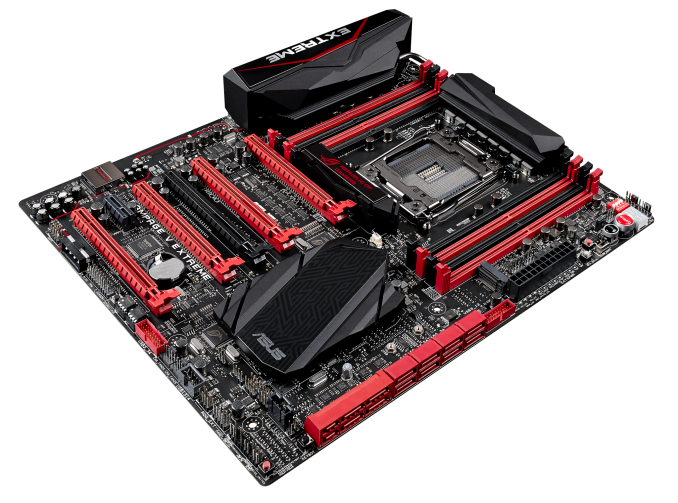
For a number of generations, each motherboard company has had its halo product that pushes boundaries and wallets. For ASUS, the Rampage IV Extreme, based on X79, was a resounding success for sales. We sourced the next chipset iteration, the X99 based Rampage V Extreme, for review to see if ASUS can follow the trend.
The Republic of Gamers Ethos
ASUS has been developing their Republic of Gamers brand for over eight years. What started off as a single motherboard is now a range of components including graphics cards, monitors, peripherals and even for storage. On the motherboard side of the equation for Intel platforms, there have been three stalwart models in the line: the micro-ATX Gene, the sound and gaming-focused Formula (ATX) and the gaming/overclocking Extreme (ATX or EATX). This has been added to in recent quarters with the Impact (mini-ITX), the Hero (cheap ATX) and the Ranger (cheap ATX also). Depending on the focus of the platform, some, none or all of these focal points are used. Traditionally the Extreme line was on all the major Intel chipsets, but this changed last year.
When Intel released the Haswell line of processors, the new LGA1150 socket was paired with the Z87 chipset and ASUS went all in with every ROG model. The purpose of Z87 was to facilitate the Haswell processor line but to also provide an upgrade to Broadwell when released. Z97 was launched when Broadwell was expected to hit the shelves, offering a similar sort of package to Z87 but with minor transitional updates. Similar circumstances happened on LGA1155 with Sandy Bridge (P67/Z68) to Ivy Bridge (Z77) in the two generations previous. What made Z97 and Intel's mainstream 9-series different for the ROG line is that only a few models were launched, and an Extreme version was absent.
At the time, although we couldn't publish it, our sources stated that it was for a singular reason: they wanted the X99 launch model to be the best, and insisted in skipping Z97 to spend more time developing the X99 model. Arguably the Z87 Extreme model existed to fill the gap anyway. This makes sense in the context that the X79 Rampage IV Extreme was the best-selling motherboard for that chipset - the need to get it right for X99 was paramount to continue.
The launch of X99 came and went in September 2014, with ASUS focusing on very few models for launch. We reviewed the X99 Deluxe, which was well received, and within the next month the X99 Pro, X99-A and the Rampage V Extreme were launched. Compared to X79, this is very few models. Depending on who you ask, the new edition of the Extreme has also not been getting as much excitement as the previous model, even with Haswell-E giving eight cores in the hands of the user.
One of the arguments for the lack of excitement might be that X79 and Sandy Bridge overclocking turned out to be a fairly big draw to gamers and enthusiasts, whereas Haswell-E’s overclocking prowess is slightly tempered. The appeal of a chipset and motherboard stack is ultimately limited by the processors the power it, so it might be the fact that Haswell-E is not as fun to overclock, or the entry price is too high, or any other number of factors. We've seen a reasonable response to our X99 coverage, which might suggest that users are still interested.
All this aside, with ASUS not even releasing an X99 based Rampage V Gene, and the launch X99 Deluxe was set at an MSRP of $400 meaning that they went all in at the high end of the most extreme platform. Personally one might feel this is slightly an oversight, especially with several other overclocking motherboards mopping up the cheaper aspect of the range. However with the mentality of the halo product, the new X99 Extreme sits exactly where it means to.
Overview
For anyone who has never invested into an ROG Extreme platform before, opening the box and playing with the contents is certainly a lot of fun. The appeal of an external OC panel, multiple bundled cables and an entry into the ROG ecosystem yields several measurable benefits. For users upgrading from a mid-range platform, such as the Z77 or Z87 models, will have the novel benefits of the extreme platform and quad channel DDR4 to have fun with. For X79 users, they might wonder why the X99 Extreme is slightly smaller, and that comes from some of the modifications that X79 Black Edition users will identify.
ASUS has been advertising (at least via their technical marketing) that the Rampage V Extreme is the culmination of many months of effort by a variety of specialists. This includes in-house experts Shamino, TL, elmor, and even former AnandTech motherboard senior editor Rajinder Gill. The results of this effort should result in a wide range of memory compatibility due to increased testing, memory overclocking due to the use of the OC socket, other board level optimizations, cleaner power delivery and tools which should allow the most extreme overclockers the control they request. In this sense, the Rampage V Extreme should build on its predecessor.
For pure functionality, the Extreme is the second Asus motherboard to be fitted with a three antenna Wi-Fi solution, a 3T3R 802.11ac. This remains a premium add-on over the now standard 2T2R and by virtue of moving from 2 to 3 should allow for a 50% bandwidth improvement when facilities allow, as well as increasing potential range in complex environments and beam forming. Alongside the Wi-Fi is SupremeFX, the upgraded Realtek ALC1150 audio solution with increased EMI shielding and PCB separation across the left hand side of the motherboard as well as a PCIe 3.0 x4 M.2 slot driven through the CPU.
As with most ASUS motherboards, all the fan headers are DC and PWM capable with four extra fan headers coming from the OC Panel, which saves space on the motherboard itself. Fans can be controlled via the BIOS using the interactive tool or through software.
The BIOS and software also get the ROG treatment, increasing the number of options for overclockers in the former and an array of gaming utilities for the operating system. This includes the newer features such as KeyBot, SoundStage and an update to Sonic Radar.
The Extreme is a formidable weapon in the arsenal, courting a $100 premium in launch price over the X99 Deluxe with that going to the OC Panel, the ROG BIOS/software packages and full support for four-way graphics in an x16/x8/x8/x8 arrangement.
Visual Inspection
As with any purchase of a high end motherboard for gaming, taking it out of the box is an experience. Only a system builder that has to put together 50 systems a week would get bored of it. Similar to other EATX motherboards, the size of the Extreme is sometimes something to be wary of, because holding it at one end causes the mass to influence torque, and you would rather not drop something that costs $500.
Taking the motherboard out of the box instantly gave me a sense of bulk, as well as the imposing black and red to which the Extreme line has been using for years. The motherboard PCB does look a bit busy, but users of substantially older Extreme models will note that a number of onboard overclock buttons are removed as they have migrated onto the OC Panel, similar to what we saw with the X79-based Rampage IV Black Edition.
The heatsink arrangement puts the eight-phase power delivery connected to the extended rear-IO cover, with the main purpose of this cover to remove the look of the normal silver on the tops of the IO ports and keep the look intact. There is another heatsink below the socket and another for the chipset. The heatsink below the socket is in an awkward location as it kind of blocks the latch for the first PCIe slot when a large GPU is installed, making it difficult to remove GPUs without a screwdriver which could, with a slip of the hand, end up removing a component.
The DRAM slots are color coded in red and black with an onboard listing to show which slots should be populated first (in this case, the red ones). These DRAM slots use single-sided latches in order to facilitate the first PCIe card, so users should ensure that the memory is firmly installed when building. The motherboard has eight fan headers, all 4-pin, with two CPU headers in the top right of the board, a CHA3B header just underneath that, two CHA1 headers to the left of the 24-pin ATX power connector, a CHA3A header to the bottom-left of the DRAM slots and two CHA2 headers at the bottom. This makes an interesting element to the design, something I have been mentioning to motherboard manufacturers on and off for about a year – one way to add headers on board is to have two connected to the same control, meaning they act together and have the same voltage applied depending on the settings. Here the Extreme has three sets of chassis headers (CHA1, CHA2, CHA3) which act as groups when it comes to fan speed and response settings for hardware and software. It is an incredibly easy design choice to make, and I am surprised it has taken one of the high end ASUS models to use the paradigm to its fullest.
At the top right of the motherboard is the ‘OC Section’, giving power/reset buttons, a two-digit debug display, PCIe disabling switches, a slow mode switch, a MemOK button, a retry button, a safe boot button and voltage read points. There is also a small number of LEDs beneath the voltage read points to indicate which part of the POST process is currently in action.
On the X79 Extreme, all the overclocking options were onboard and a bundled display adapter for DVI-D was provided. However the X99 Extreme has gone the way of the X79 Black Edition which uses a separate bundled OC Panel with a display to be able to change and view frequencies and voltages on the fly. It also doubles up as a fan controller for system builds.
We covered the OC Panel is great detail in our review of the X79 Black Edition so we won’t say much more here, except that if we look under the panel:
Here we get four additional fan headers, a slow mode switch, a pause switch, two VGA headers for voltage sensing and manipulation, with voltage points and supplementary SATA power as well. By partitioning some of these elements off to the panel, it allows for less complexity on the board for design as well as when it comes to RMA. At this point it might be worth mentioning that I rarely see extreme overclockers using the OC Panel outside of the basic controls due to the increase in VGA capabilities of external power cards. That being said, the OC Panel is designed to work as a display in a case as well with fan options, information on CPU temperatures and so forth.
Moving below the OC section on the motherboard gives us a PCIe 3.0 x4 M.2 slot which accepts PCIe drives at 2260, 2280 and 22110 dimensions (22x60mm, 22x80mm, 22x110mm). One of the USB 3.0 headers is here in red, and then follows a total of twelve SATA ports. The X99 chipset supports two AHCI controllers – one with RAID for six SATA ports, and one without for four SATA ports. Here the top six have RAID, whereas the next two do not. The X99 Extreme also has two SATA Express ports – one from the chipset and another via an ASMedia controller. Given the state of the market on SATA Express, it makes me wonder if we will ever see any commercial drives for it.
Below the SATA ports is the Keybot reset button, two SATA Express clock connections and a Thunderbolt header required for Thunderbolt use. The main bottom side of the motherboard also includes a BIOS Switch button for flicking between the BIOS chips, a front panel header, the OC Panel header (called ROG_EXT) which also has a USB 2.0 header, another USB 2.0 header, a second USB 3.0 header, the two Winbond 128Mb BIOS chips, a Soundstage button, a thermistor temperature sensor header, a TPM header, a four-pin molex for extra PCIe power and the front panel audio. Perhaps somewhat unfortunately we get a molex PCIe power connecter here for VGA power in 3-4 card situations – personally I prefer an extra 6-pin PCIe or a SATA power connector, but at this point due to how the board is designed the molex is the easiest to accomplish here.
The audio subsystem uses SupremeFX, ASUS’ brand for an enhanced Realtek ALC1150 solution with several added features. On the top are standard improved features – PCB separation of the audio channels as well as analog/digital signals, an electromagnetic shield for the codec itself, filter caps for the front panel audio and automatic headphone detection for low and high impedance headsets. The feature that users might not be familiar with is SoundStage which performs a configurable hardware based transform on the audio signal though the software. It comes with for presets for typical gaming scenarios (Driving, FPS and so on), although users can configure their own.
The PCIe layout might be a little difficult to get around. With 40 PCIe lane CPUs, the processor supplies x16/x8/x16/- in tri-GPU mode through the red slots or x16/x8/x8/x8 in quad mode. When the M.2 x4 is connected, the bottom PCIe slot reduces down to x4 mode, which means that quad-SLI is only available when the M.2 is not in use. With the i7-5820K, this reduces down to x16/-/x8 for dual graphics and x8/x8/x8 for three-way, leaving the bottom red slot disabled.
The black slot in the middle is a PCIe 2.0 x4 slot, which also comes with its own oddities. It can work in x1, x2 or x4 mode, and shares bandwidth with the first PCIe 2.0 x1 slot, two USB 3.0 ports on the rear panel and the top ASMedia SATA Express connector. When the PCIe x4 slot is in x4 mode, the USB ports, the PCIe x1 and the SATA Express are all disabled. When the PCIe x4 slot is in x2 or x1 mode, the PCIe x1 and USB3 ports are enabled, and SATA Express is only enabled with the PCIe x4 slot is disabled. In other words:
Here lies on of the fundamental issues to supporting many technologies on the same product. At some point you run out of bandwidth or space for routing, so in the end some features become an either/or scenario. The product is marketed as having them all, but the reality is split. Luckily in this case SATA Express is of limited use, and losing two SATA ports out of 12 is not that much of a loss when there are other PCIe slots available.
The rear panel is practically full, and it comes enclosed in the shroud fitted to the motherboard. The shroud is designed to complete the look of the motherboard by removing the silvery IO ports from sight. On the back itself we get Clear CMOS and ROG Connect buttons, two USB 2.0 ports (bottom port for ROG Connect), a PS/2 combination port, 10 USB 3.0 ports (from ASMedia hubs), an Intel I218-V network port, the 802.11ac 3T3R dual band WiFi module and the audio jacks with an more gold plating. Two things are worth noting here – the network port is part of ASUS’ GameFirst III strategy which includes LANGuard shielding and surge protection, but also that the BIOS Flashback utility has been moved from a rear button to the same as the ROG Connect and USB port.
Board Features
| ASUS ROG Rampage V Extreme (X99) | |
| Price | US |
| Size | E-ATX |
| CPU Interface | LGA2011-3 |
| Chipset | Intel X99 |
| Memory Slots | Eight DDR4 DIMM slots supporting up to 64 GB Up to Quad Channel, 1600-3300 MHz |
| Video Outputs | None |
| Network Connectivity | Intel I218-V Dual Band 3T3R 802.11ac |
| Onboard Audio | Realtek ALC1150 (via SupremeFX) |
| Expansion Slots | 4 x PCIe 3.0 x16 - 40 PCIe CPU: x16, x16/x16, x16/x8/x8, x16/x8/x8/x8 - 28 PCIe CPU: x16, x16/x8, x8/x8/x8 1 x PCIe 2.0 x4 1 x PCIe 2.0 x1 |
| Onboard Storage | 6 x SATA 6 Gbps, RAID 0/1/5/10 4 x S_SATA 6 Gbps, no RAID 2 x SATA 6 Gbps via ASMedia 1 x SATA Express (PCH) 1 x SATA Express (ASMedia) 1 x PCIe 3.0 x4 M.2 (2260/2280/22110) |
| USB 3.0 | 6 x USB 3.0 via PCH (2 headers, 2 rear panel ports) 10 x USB 3.0 via ASMedia Hubs (8 rear panel ports) |
| Onboard | 12 x SATA 6 Gbps 2 x SATA Express 1 x M.2 x4 2 x USB 3.0 Headers 2 x USB 2.0 Headers 8 x Fan Headers TPM Header Thunderbolt Header MemOK! Button Slow Mode Switch 9 x Voltage Measurement Points 3 x Thernal Sensors Power/Reset Buttons BIOS Switch LN2 Mode Jumper ROG Extension Header Keybot Button SoundStage Button Safe Boot Button ReTry Button Front Panel Audio Header Front Panel Header |
| Power Connectors | 1 x 24-pin ATX 1 x 8-pin CPU 1 x Molex (for PCIe) |
| Fan Headers | 1 x CPU (4-pin) 1 x CPU_OPT (4-pin) 6 x CHA (4-pin) |
| IO Panel | 1 x PS/2 Combination Port 1 x Intel I218-V Network Port 2 x USB 2.0 10 x USB 3.0 via ASMedia Clear CMOS Button ROG Connect Button WiFi Module (3T3R 802.11ac) Audio Jacks |
| Warranty Period | 3 Years |
| Product Page | Link |


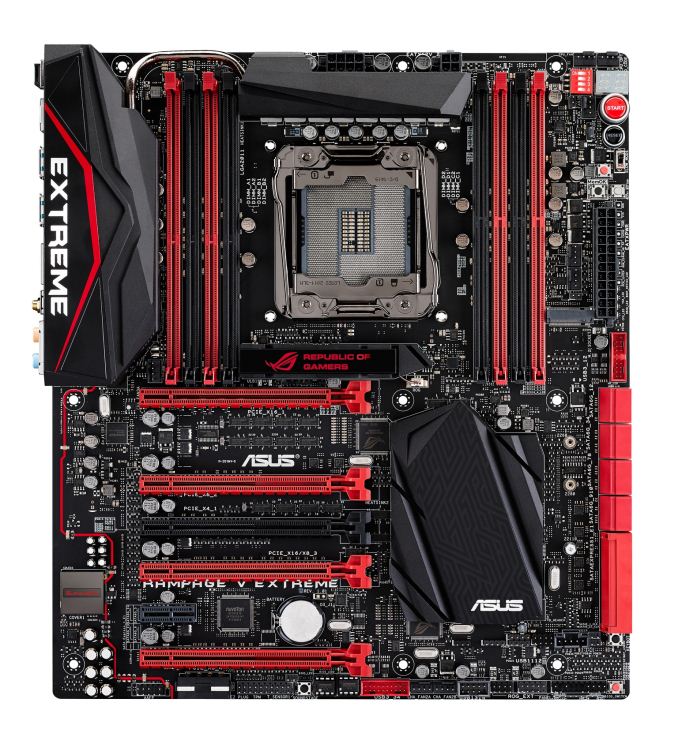

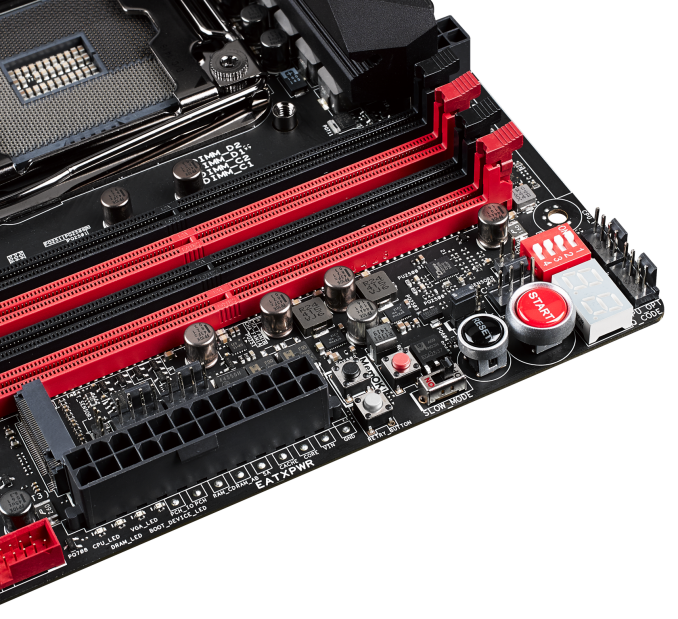
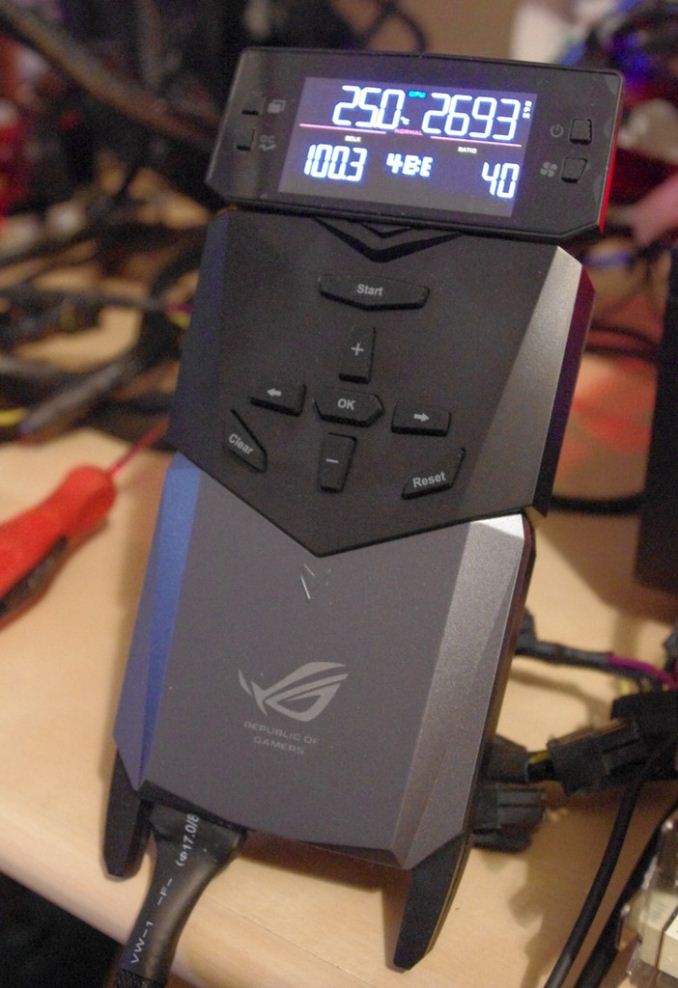
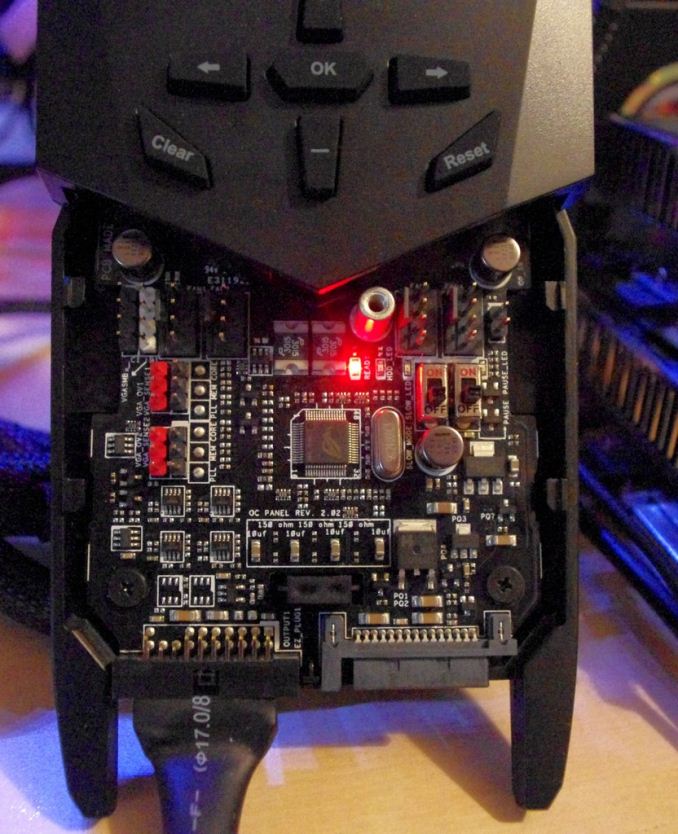
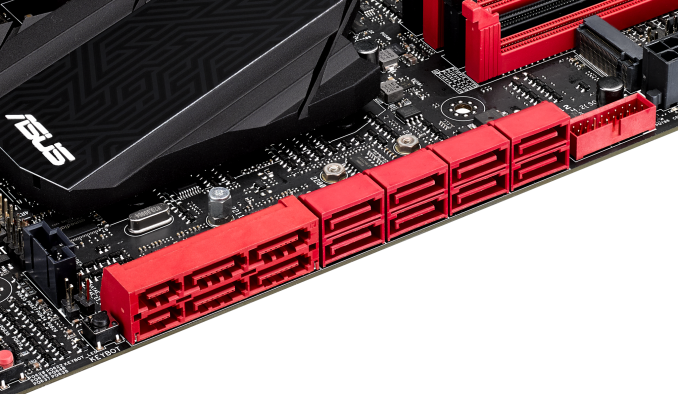
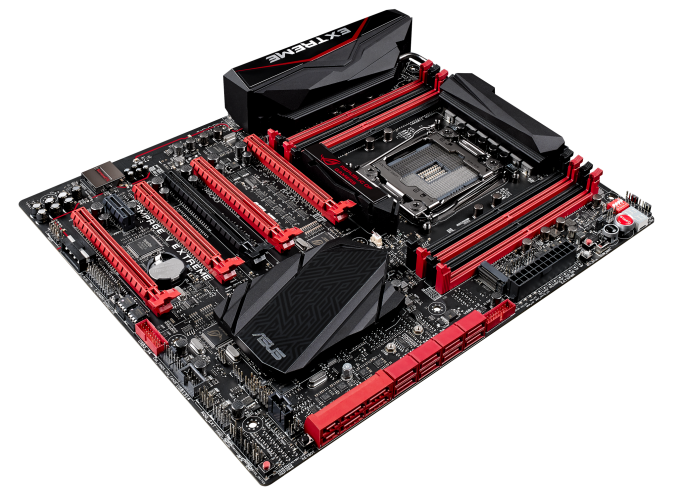
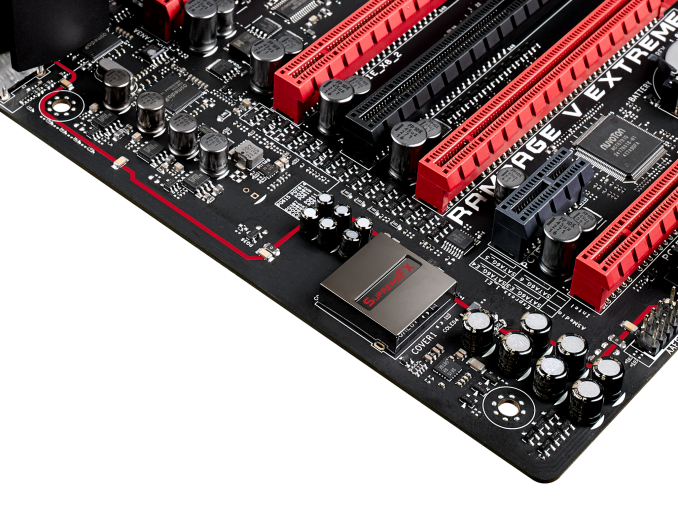
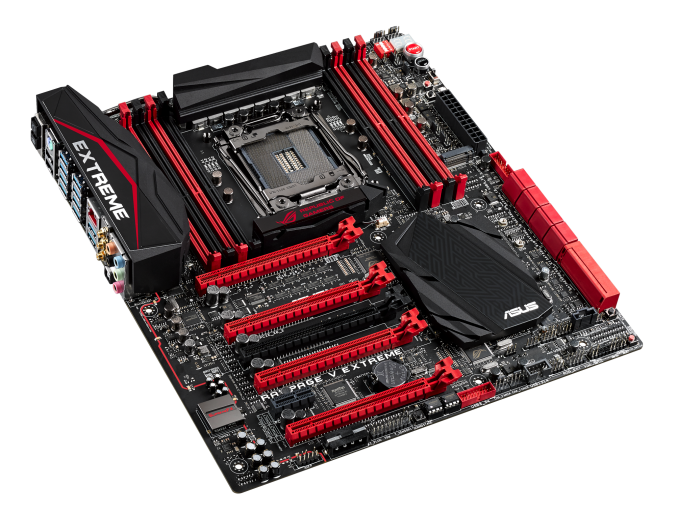


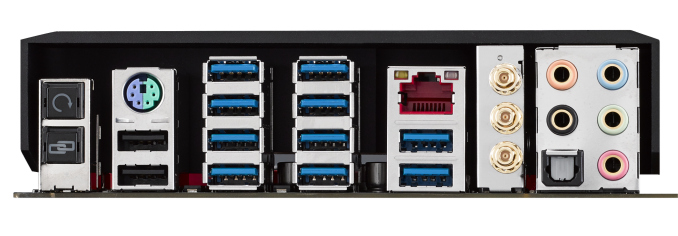














41 Comments
View All Comments
Malahmen - Friday, January 27, 2017 - link
I would like to warn you on this one.You can't even run a single GPU + a m.2 on that board with a 5820k because it has 28 lanes.
The board disables the 4th PCIe slot, which is shared with the m.2 slot, so no m.2 slot as soon as the bios takes over.
bottom line, you might boot from a pen drive, start to install your SO on the ssd, but after restarting, the bios wont detect the ssd (so you wont be able to select it as boot drive) because detecting your cpu, the board will shut the 4th PCIe (and your m.2 slot).
You might be able to do that with a 5930k though.